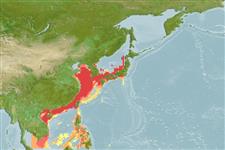分类 / Names
俗名 | 同种异名 | Catalog of Fishes(属, 种) | ITIS | CoL | WoRMS | Cloffa
Elasmobranchii
板鳃亚纲 (鲨鱼与 鱼) (sharks and rays) >
Orectolobiformes (Carpet sharks) >
Orectolobidae (Carpet or nurse sharks)
Etymology: Orectolobus: orektos (Gr.), stretched out; lobus (L.), from lobos (Gr.), rounded projection or protuberance, referring to long nasal barbels of Squalus barbatus (=O. maculatus). (See ETYFish); japonicus: -icus (L.), belonging to: Japan, described from two specimens, both from Japan. (See ETYFish).
More on author: Regan.
Environment: milieu / climate zone / depth range / distribution range
生态学
海洋 居于水底的; 深度上下限 0 - 200 m (Ref. 106604). ; 43°N - 6°N, 103°E - 140°E
Western Pacific: Japan and Korea to Viet Nam.
Length at first maturity / 大小 / 重量 / 年龄
Maturity: Lm ?, range 103 - ? cm
Max length : 118 cm TL 雄鱼/尚未辨别雌雄; (Ref. 106604)
简单描述
型态特徵 | 形态测量图
背棘 (总数): 0; 背的软条 (总数): 0; 臀棘 0; 臀鳍软条: 0. Five to six dermal flaps below and in front of eyes; back with light areas between dark saddles marked with broad reticulated dark lines (Ref. 13577). Caudal fin with its upper lobe hardly elevated above the body axis, with a strong terminal lobe and subterminal notch but no ventral lobe (Ref. 13577).
A little-known bottom shark found inshore (Ref. 247); usually in sand or sandy mud bottoms (Ref. 11230); also on rocky and coral reefs (Ref. 43278). Nocturnal in habits (Ref. 247). Feeds on fish and presumably bottom invertebrates (Ref. 247), including lizardfishes, cutlassfish, horse mackerel and other jacks, goatfishes, groupers, tilefishes, sea robins, whiting, parrotfishes, sea bream, croakers, also skates, shark egg cases, cephalopods, and shrimp (Ref. 43278). Ovoviviparous (Ref. 43278, 50449), with up to 20 young in a litter (Ref. 247). Wobbegongs should be regarded as potentially dangerous because of its formidable dentition (Ref. 247, 13577). Used for human consumption (Ref. 247). Kept in aquaria in Japan and the United States (Ref. 43278).
Life cycle and mating behavior
成熟度 | 繁殖 | 产卵场 | 卵 | 孕卵数 | 仔鱼
Ovoviviparous, embryos feed solely on yolk (Ref. 50449). With up to 20 young in a litter (Ref. 247).
Compagno, L.J.V., 1984. FAO Species Catalogue. Vol. 4. Sharks of the world. An annotated and illustrated catalogue of shark species known to date. Part 1 - Hexanchiformes to Lamniformes. FAO Fish. Synop. 125(4/1):1-249. Rome, FAO. (Ref. 247)
人类利用
渔业: 低经济
更多信息
年龄范围成长体长-体重体长-体长体长-频率形态测量图型态特徵仔鱼稚鱼动力学入添量丰度BRUVS
参考文献养殖养殖信息品种遗传学Electrophoreses遗传率疾病加工NutrientsMass conversion
工具
特别资料
下载 XML
网络资源
Estimates based on models
Preferred temperature (Ref.
123201): 14.5 - 27.7, mean 24 °C (based on 222 cells).
Phylogenetic diversity index (Ref.
82804): PD
50 = 0.5012 [Uniqueness, from 0.5 = low to 2.0 = high].
Bayesian length-weight: a=0.00389 (0.00180 - 0.00842), b=3.12 (2.94 - 3.30), in cm total length, based on all LWR estimates for this body shape (Ref.
93245).
营养阶层 (Ref.
69278): 3.8 ±0.57 se; based on food items.
回复力 (Ref.
120179): 低的, 最小族群倍增时间4.5 - 14 年 (Fec=20).
Fishing Vulnerability (Ref.
59153): High to very high vulnerability (71 of 100).
